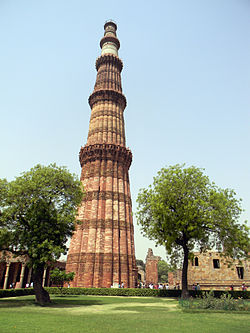Qutub Minar
From Wikipedia, the free encyclopedia
This article is about the brick minar. For the entire complex, see Qutub complex.
| Qutub Minar | |
|---|---|

Qutub Minar in Delhi, India
| |
| Type | Cultural |
| Criteria | (iv) |
| Designated | 1993 (17th session) |
| Reference No. | 233 |
| Country | |
| Continent | Asia |
Qutub Minar (The Qutub Tower; Urdu: قطب مینار), also known as Qutb Minar and Qutab Minar, is the tallest minar in India, originally an ancient Islamic Monument, inscribed with Arabic inscriptions, though the iron pillar has some Brahmi inscriptions,[1]and is a UNESCO World Heritage Site.[2] Located in Delhi, the Qutub Minar is made of red sandstone and marble. The tower has 379 stairs,[3] is 72.5 metres (237.8 ft) high, and has a base diameter of 14.3 metres, which narrows to 2.7 metres at the top storey. Construction was started in 1192 by Qutub-ud-din Aibak and was completed by Iltutmish. [4][5] It is surrounded by several other ancient and medieval structures and ruins, collectively known as the Qutub complex.[1][6]
Structure[edit]
The Qutab Minar is made of red sandstone covered with intricate carvings and verses from the Qur'an.It is built by Qutub-ud-din Aibak Numerous inscriptions in Parso-Arabic and Nagari characters in different sections of the Qutub Minar reveal the history of its construction. According to the inscriptions on its surface it was repaired by Firoz Shah Tughlaq (AD 1351–88) and Sikandar Lodi[7](AD 1489–1517).[citation needed]
The Qubbat-ul-Islam Mosque, located at the northeast of Minar, was built by Qutub-ud-din-Aibak in AD 1198. It is the earliest mosque built by the Delhi Sultans.[8] Later, a coffee arched screen was erected and the mosque was enlarged by Shams ud Din Iltutmish (AD 1210–35) and Allaud — din Khilji. The Iron Pillar in the courtyard bears an inscription in Sanskrit in Brahmi script of the 4th century AD. According to this inscription, the pillar was set up as a Vishnudhvaja (standard of Lord Vishnu) on the hill known as Krishnapada in memory of a mighty king named Chandra. A deep socket on the top of the ornate capital indicates that an image of Garuda was probably affixed to it.
The Qutub Minar comprises several superposed flanged and cylindrical shafts, separated by balconies carried on Muqarnas corbels. The Qutub Minar is itself built on the ruins of the Lal Kot, the Red Citadel in the city of Dhillika, the capital of the Tomars and theChauhans, the last Hindu rulers of Delhi.[9] One engraving on the Qutub Minar reads, "Shri Vishwakarma prasade rachita" (Conceived with the grace of Vishwakarma).
The Qutub Minar was used as a watch tower. The earliest extant mosque was built by the Delhi Sultans. Some historians believe that the Qutub Minar was named after the first Turkic sultan (whose descendant- Wajid Ali Shah-repaired it), Qutub-ud-din Aibak,[10] but others contend that it was named in honour of Qutubuddin Bakhtiar Kaki,[11] a saint from Transoxiana who came to live in India and was venerated by Iltutmish.[12]
The nearby Iron Pillar is a metallurgical curiosity, standing in the Qutub complex. According to the traditional belief, anyone who can encircle the entire column with their arms, while standing with their back against the pillar, can have their wish granted. Because of the corrosive qualities of sweat the government has built a fence around it for safety. The amalgamation of different metals with iron produces a high degree of smoothness.
The Qutub Minar has been damaged by earthquakes and lightning strikes on several occasions but has been repaired and renovated by various rulers. During the rule of Firoz Shah, the minar's two top floors were damaged due to lightning but were repaired by Firoz Shah. In 1505, an earthquake struck and it was repaired by Sikandar Lodi. Later in 1794, the minar suffered another earthquake and it was Major Smith, an engineer, who repaired the affected parts of the Qutub Minar. He replaced Firoz Shah's pavilion at the top of the tower with his own pavilion. This pavilion was removed in 1848 by Lord Hardinge and now stands between the Dak Bungalow and the Minar in the garden. The floors built by Firoz Shah can be distinguished easily as the pavilion was built of white marble and quite smooth compared to the others.
Qutub Minar tilts just over 60 cm from the vertical, which is considered to be within safe limits, although experts have stated that monitoring is needed in case rainwater seepage further weakens the foundation.[13]
Media use[edit]
Bollywood actor and director Dev Anand wanted to shoot the song Dil Ka Bhanwar Kare Pukarfrom his movie Tere Ghar Ke Samne inside the Qutub Minar. However, the cameras in that era were too big to fit inside the tower's narrow passage, and the song was shot inside a replica of the tower instead.[14] The site served as the pitstop of the second leg of the second season ofThe Amazing Race Australia, the Australian version of the Emmy-winning series The Amazing Race. This is the first Indian monument to have an E-ticket facility. Qutub Minar is the closest station on the Delhi Metro. A picture of the minaret is featured on the Travel Cards issued by the Delhi Metro Rail Corporation.
Qutub Tragedy[edit]
Before 1981, the general public could climb to the top of Qutub Minar by climbing up the seven-storey, narrow staircase. However, on 4 December 1981 an accident occurred when an electricity cut plunged the tower's staircase into darkness. Around 45 people were killed in the stampede that followed the electricity failure. Most of the victims were children because, before 1981, school children were allowed free access to historical monuments on Fridays, and many school groups were taking advantage of this. Subsequently, public access has been forbidden.[15]


















1 comment:
Corbett National Park Corbett National Park National park is one of the best place to explore the wildlife in Uttarakhand.
Post a Comment